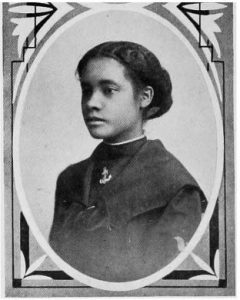
Sadie Samuels’ high school yearbook picture, 1911
Sadie Samuels was born in 1892 in Cincinnati’s West End. In the 1900 census the household included the eight-year-old Sadie, an African-American girl; her grandfather Thomas Young, a wounded veteran of the US Colored Troops during the Civil War; her father James who worked on the railroad; her mother Margaret and her baby brother James, born in 1899. From the mid 1890’s the family most often appeared in the directory at 1734 Baymiller in the old West End, although they occasionally had other nearby addresses. Sadie’s father died in about 1906; Sadie’s mother Margaret moved with Sadie’s grandfather and brother a few blocks away. In 1909 Margaret bought a house at 1736 Baymiller, next door to the house she had shared with her husband.
Despite her father’s death, Sadie continued her education; in 1911 she graduated from Woodward High School – at a time when such a diploma was unusual even for white boys. Beginning the next year, she had her own entry in the Williams city directory at her mother’s house, working as a waitress while continuing her studies. Sadie would live with her mother at that address for more than a decade. Sadie enrolled in the University of Cincinnati by 1913. During the summer of 1914 she worked as an assistant in a “Vacation School” for poor Black children run by the great educator Jennie Porter at the old Hughes High School building downtown. That fall, Porter convinced the white-controlled school board to open a new school for African American students, named after Harriet Beecher Stowe; like Frederick Douglass School in Walnut Hills it went through eighth grade, reestablishing segregated education for most Cincinnati students.
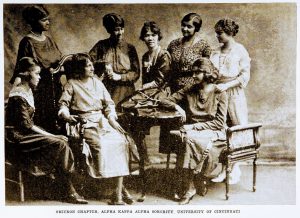
Alpha Kappa Alpha Sorority 1921
This resegregation of the Cincinnati Public Elementary Schools did have the effect of creating new teaching jobs for qualified Blacks; Sadie Samuels began regular teaching in the system in 1919, finally giving up her career as a waitress. Continuing her practice of working and going to school, she remained at UC through 1924 receiving various diplomas, culminating in a Bachelor of Science in Kindergarten. Miss Samuels also acted as a leader among the Black women on campus: she was an early member of the Alpha Kappa Alpha sorority graduate chapter at UC established in 1921, about the same time as the Black Alpha Phi Alpha fraternity on campus.
In 1924 Sadie and her mother bought another residence, still in the West End, at 1625 Dudley. Sadie’s teaching assignment moved to Frederick Douglass School in 1927; mother and daughter rented out the house on Dudley and bought a new home at 2630 Park Avenue in Walnut Hills. It was a modestly sized house around the corner from Douglass and next door to the Black real estate mogul Horace Sudduth. While she never married, Sadie was hardly a little spinster schoolmarm. She would remain active in the housing market for decades – buying and selling buildings, taking and closing mortgages, collecting rents and dealing with the annoyances of lawsuits and utility shut-offs – and would eventually engage Sudduth as her agent for some rental properties. She was what a white man with similar property would have been called a person of substance.
Sadie Samuels, with her degree in Kindergarten education, eventually became the “teacher-in-charge” at the Douglass Colony School. She was the principal in everything but name and pay. The Colony School, a half-hearted response to overcrowding at the main Douglass campus on Alms Place, was located on the west side of Gilbert Avenue, near Blair. It mostly served students in the Schmidlapp Model Homes developments around Washington Terrace, segregated but modern and well-run apartments. The Colony, at least initially, served the younger children and saved them from the hazardous crossing of busy Gilbert. The Colony never had facilities comparable to “Big Douglass” with its auditorium, gymnasium, library, showers and more: students from the Model Homes developments enjoyed hot and cold running water and community facilities. Yet the growing number of children in the surrounding tenements faced substandard housing with no relief to be found at school.
Stay tuned; we shall see that Sadie Samuels, with her secure professional job and her relative affluence, played an important role in Black Walnut Hills and in the city during the growing Civil Rights movement of the middle of the twentieth century.
Networks of Single Black Women
Sadie Samuels, a teacher in the segregated Cincinnati Public Schools from the 1920s through the ‘50’s, leveraged her position and real estate holdings to become a major player in Cincinnati’s Black community. We might wonder how a single Black woman achieved a position of influence and respect in Walnut Hills, Cincinnati and the larger nation in the mid twentieth century. Upon closer examination, however, we find that she owed her success to, and shared her power with, an established network of well-educated peers.
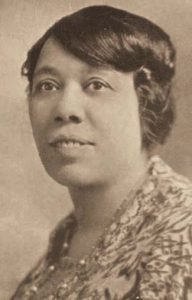
Miss Samuels achieved her status with the help of a mentor. In Miss Samuels’ case the mentor was Jennie Porter, the principal of the public, segregated Harriet Beecher Stowe School in the old West End. Miss Porter had taught at Frederick Douglass School in Walnut Hills from 1897 through the spring of 1914. We have seen that Miss Samuels, a UC student at the time, served as an assistant at Porter’s “Vacation School” over the summer of 1914. (Miss Porter in turn received financial support from Miss Annie Laws, a wealthy white philanthropist who helped organize both the UC School of Nursing and the Kindergarten School, which became the School of Education.)
Another strong bond undoubtedly developed when forty-year-old Jennie Porter, who had started teaching before UC offered teacher education, enrolled at the University in 1918. She would earn her bachelor’s and master’s degrees, like Sadie Samuels (who was in her late twenties). Miss Porter would further go on to become the first African American woman to achieve a Ph. D. from UC. In 1919, Miss Samuels began teaching under Principal Porter at Stowe. The pair would also have met Ida Mae Rhodes, who graduated from UC in 1919 at the age of twenty and stayed on for a couple more years finishing a master’s degree. In 1922 she began teaching at Frederick Douglass. In 1920 Miss Rhodes became the first president of the Alpha Kappa Alpha Sorority; Miss Samuels would become a “Soror” (sorority sister). Sadie Samuels followed Jennie Porter into another institution in the Black community.
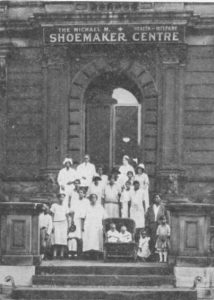
Medical care in the West End was spotty and difficult. In 1926 a Fourth Street mansion donated by the Shoemaker family to the Community Chest was turned into a medical clinic by Negro Civic Welfare Association and the Better Housing League. It became the closest thing to a hospital available to Black doctors at the time. It also housed the offices of the Association. Jennie Porter sat on the original board of the Shoemaker Center. In 1930, Sadie Samuels replaced Dr. Porter on the board. (It’s interesting to note that her election was covered in Cincinnati’s American Israelite newspaper. Her social justice positions often overlapped with the Jewish community.) In 1930 Miss Samuels also appeared on the program of a special service at the Black Ninth Street YMCA downtown; she maintained a life-long relationship with both the YMCA and the YWCA.
Miss Samuels would continue her own education throughout her career, finishing a master’s at UC and summer studies at the University of Chicago, and (in 1953) with Ohio University students in France, Italy and Spain. Reflecting her own support from the Black community, she personally sponsored Soror Merze Tate who in 1933 won a foreign fellowship from the national Alpha Kappa Alpha Sorority. Miss Tate was a teacher at the Black Crispus Attucks School in Indianapolis; she took advantage of the fellowship to begin study at Oxford University in England. After the one-year A. K. A. fellowship expired, Miss Samuels was among individual donors who allowed an extension to Miss Tate, who also won a year’s support from Oxford. “Throughout the three years that I spent at Oxford, I was ever conscious of being a pioneer representing Alpha Kappa Alpha Sorority in particular and Negro Womanhood in general.” She studied the movement for disarmament before the [First] World War – a momentous subject during the rise of the Nazis in Germany – and she traveled extensively throughout Europe for her research. Tate was the first woman of color, and the first African American, to receive an advanced degree from Oxford, in 1936, and became the first woman of any demographic at Oxford to take her degree supervised by two full Professors. She went on to earn a Ph. D. from Harvard’s Radcliffe women’s college. Dr. Tate would eventually teach at Howard University. Like Jennie Porter, Sadie Samuels and Ida Mae Rhodes, she never married.
Sadie Samuels herself became President of the local Alpha Kappa Alpha sorority in 1943. In the desperate year of 1943, she urged her fellow Sorors to a show of patriotism. “War Bond and Stamp sales for a single day in the Shillito Victory Window reach a new high Tuesday, when the A. K. A. Negro sorority chalked up a record of $2,493 of Series E bonds, $1,100 of Series G bonds, and $52.80 worth of Ward Stamps. This made a total of $3,646.55 that Miss Sadie Samuels, President, reported to … the Hamilton County War Savings Staff. The previous high for a day was less than $2,500.” A few cents difference in the numbers seem more likely the sloppiness of the reporter than of the meticulous Miss Samuels.
The Sorors showed the same pride as contemporary “Race Men.” Sadie Samuels paid her part of this investment in America using her own resources. This public affirmation of independence and power was of a piece with her life-long association with strong, single African American women.
Civil Rights activist in the mid twentieth century
Miss Sadie Samuels, a teacher in the segregated Cincinnati Public Schools, began her most important Civil Rights work during World War II. She served as a charter member of the Mayor’s Friendly Relations Committee in 1943, later renamed the Cincinnati Human Relations Commission.
The Mayor’s Friendly Relations Committee was a peculiarly Cincinnati institution. As had happened during World War I, a great number of African Americans migrated from the South to the Industrial North to take jobs in War Production. Crowding and competition for jobs caused racial tensions in many Northern cities, and serious riots – mostly white on Black violence – erupted in Detroit and St. Louis. Rather like Douglass teacher James Robinson’s Negro Civic Welfare Association emerging from World War I, the quaintly named Friendly Relations Committee sought to organize local forces to protect minority citizens – at the time, Jews as well as Blacks were particularly vulnerable. Putting the usual positive spin on the situation in the Queen City, most accounts declare total success. When the newspapers revealed a “Three-Point Plan Offered for preventing Race Riot” in the wake of white on Black violence in Detroit, it was a rather thin one. The mayor agreed to give a radio talk on “Tolerance” (the quotes around the word were in the original); to invite Civic leaders to a meeting to be called “This must not happen here;” and to arrange a conference for Black community leaders to meet with the City Manager, the Safety Director and the Police Chief.
A more realistic and sobering evaluation must take into account the isolated example of a house occupied by two Black families in Mt. Adams in 1944. A crowd of 100 white men stoned the house, driving the occupants from the white, largely blue-collar neighborhood. Similarly, the Fair Employment Practices Committee noted that there was widespread racial discrimination in War Production industries – explicitly acknowledged by large corporations that generally claimed that hiring Blacks would result in strikes and even race riots on the part of their white workers. It is perhaps more accurate to say that the Black community in the city was able to counsel newcomers, mostly from the South where unwritten rules were clearly understood, about which neighborhoods were safe. Rather like the Negro Motorist’s Greenbook, the Friendly Relations Committee was a reflection, rather than a softening, of Jim Crow policies. Likewise, it is a reflection of the role of women in the Black community in Cincinnati rather than a larger symbol of women’s rights, that Sadie Samuels was in a position to advocate for and serve on the Committee.
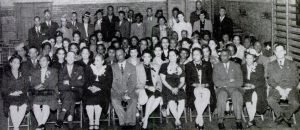
NAACP Cincinnati “Pancas” photo for top membership recruiters. Sadie Samuels solicited 145 members. She is in the front row, fifth from the right — she is at the center of three women near the center of that row. President Theodore Berry is at the right in the front row.
Miss Samuels rose at the end of World War II as a vice president of the more radical NAACP. She became a vice president of the Cincinnati chapter of the NAACP in 1945; Theodore Berry, later the city’s first African American Mayor, was chapter president. Miss Samuels headed a committee of 400 volunteers aimed at recruiting 10,000 members as the civil rights organization stepped into the leadership of the Civil Rights movement in the crucial post-war years. The campaign reached its goal.
Along with her success at the NAACP, Miss Samuels took on several other fundraising projects in the African-American community in Cincinnati. In 1946-47 she headed a campaign to raise money for “a home for the Negro blind,” who were excluded from the presence of sightless whites. The campaign fell short of its goal of $15,000, but brought in more than $10,000 to purchase and renovate a house at 411 Clinton Street, near the Black settlements in Lockland and Lincoln Heights.
In Walnut Hills, during the 1940s Miss Samuels served on the committee set up in 1943 to purchase the house built by Lane Seminary in 1832 for Lyman Beecher. A rooming house in danger of demolition in the post-war building boom, it was the only structure remaining in the city with a clear connection to Harriet Beecher Stowe, the author of the abolitionist novel Uncle Tom’s Cabin. The building would be dedicated in 1949 as the Harriet Beecher Stowe House to preserve the memory of the author of Uncle Tom’s Cabin and the “history of the Negro race.” It was Sadie Samuels who turned over the deed of the house to the governor of Ohio in 1946.
Finally, Miss Samuels headed up the fundraising effort for the West End YWCA in 1957. Passing the torch to a new generation, in 1959 she sat at a table in celebration of the YWCA with Donald Spencer, her one-time faculty colleague at Frederick Douglass, and his wife Marian who would become the first African American woman on city council.
 Miss Samuels achieved her status with the help of a mentor. In Miss Samuels’ case the mentor was Jennie Porter, the principal of the public, segregated Harriet Beecher Stowe School in the old West End. Miss Porter had taught at Frederick Douglass School in Walnut Hills from 1897 through the spring of 1914. We have seen that Miss Samuels, a UC student at the time, served as an assistant at Porter’s “Vacation School” over the summer of 1914. (Miss Porter in turn received financial support from Miss Annie Laws, a wealthy white philanthropist who helped organize both the UC School of Nursing and the Kindergarten School, which became the School of Education.)
Miss Samuels achieved her status with the help of a mentor. In Miss Samuels’ case the mentor was Jennie Porter, the principal of the public, segregated Harriet Beecher Stowe School in the old West End. Miss Porter had taught at Frederick Douglass School in Walnut Hills from 1897 through the spring of 1914. We have seen that Miss Samuels, a UC student at the time, served as an assistant at Porter’s “Vacation School” over the summer of 1914. (Miss Porter in turn received financial support from Miss Annie Laws, a wealthy white philanthropist who helped organize both the UC School of Nursing and the Kindergarten School, which became the School of Education.) Medical care in the West End was spotty and difficult. In 1926 a Fourth Street mansion donated by the Shoemaker family to the Community Chest was turned into a medical clinic by Negro Civic Welfare Association and the Better Housing League. It became the closest thing to a hospital available to Black doctors at the time. It also housed the offices of the Association. Jennie Porter sat on the original board of the Shoemaker Center. In 1930, Sadie Samuels replaced Dr. Porter on the board. (It’s interesting to note that her election was covered in Cincinnati’s American Israelite newspaper. Her social justice positions often overlapped with the Jewish community.) In 1930 Miss Samuels also appeared on the program of a special service at the Black Ninth Street YMCA downtown; she maintained a life-long relationship with both the YMCA and the YWCA.
Medical care in the West End was spotty and difficult. In 1926 a Fourth Street mansion donated by the Shoemaker family to the Community Chest was turned into a medical clinic by Negro Civic Welfare Association and the Better Housing League. It became the closest thing to a hospital available to Black doctors at the time. It also housed the offices of the Association. Jennie Porter sat on the original board of the Shoemaker Center. In 1930, Sadie Samuels replaced Dr. Porter on the board. (It’s interesting to note that her election was covered in Cincinnati’s American Israelite newspaper. Her social justice positions often overlapped with the Jewish community.) In 1930 Miss Samuels also appeared on the program of a special service at the Black Ninth Street YMCA downtown; she maintained a life-long relationship with both the YMCA and the YWCA.

